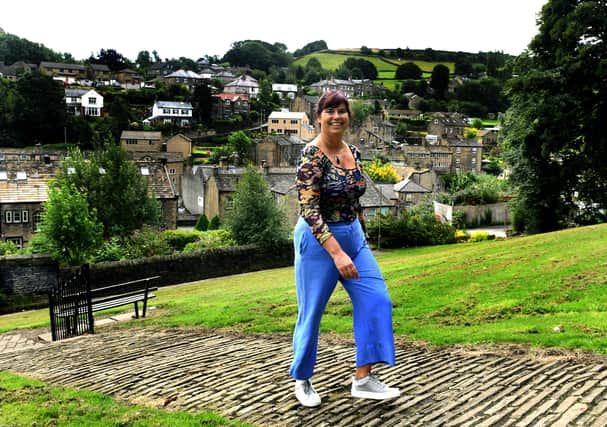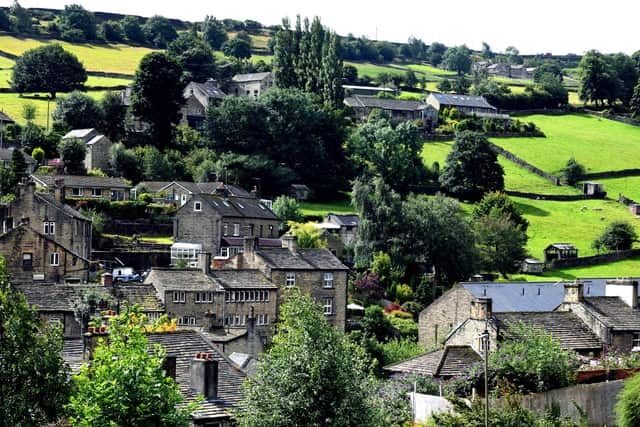Yorkshire’s market town gems – How Holmfirth reinvented itself as arts hub


But then something unexpected happened in Holmfirth.
As the beating heart of the textile industry went on to life support, as unemployment rose and property values tumbled, a new generation of post-industrialists moved in.
Many were artists, but few were cast in Lowry’s mould. For them, the town was a blank canvas.
Advertisement
Hide AdAdvertisement
Hide Ad

It was not the only Pennine enclave to be reinvented. On the other side of Huddersfield, Hebden Bridge also saw an influx of ofcumdens who ate muesli, wore sandals and bought up cheap property. They too brought new prosperity in their wake.
But Holmfirth, in the centre of a triangle bounded roughly by Leeds, Sheffield and the Peak District, developed in the idiosyncratic way it always had.
“It’s never lost its essential character,” says Steve Sykes, a retired teacher born and bred there, whose life connects the old and new Holmfirth.
He is chair of the Holmfirth Arts and Music festival, one of half a dozen annual events that have helped transform an old mill town into a cultural hub.
Advertisement
Hide AdAdvertisement
Hide AdIt was a future he could not foreseen when he left school and went to work at the long-flattened mill his father managed. It was one of around 60 in the vicinity.
He left to do a chemistry degree, but remembers the cultural scene he left behind. “Until I was 20, Holmfirth was about brass bands, choral societies and a few local painters – that was the arts community back then,” he says.
“But with the decline of textiles, houses became so cheap that many people saw an opportunity to move into the area.
“It changed the feel of the place and now we have folk, film, arts and sculpture events, wine bars, coffee bars and a local brewery.”
Advertisement
Hide AdAdvertisement
Hide AdHolmfirth also has a mainstream music venue in the Picturedrome on Market Walk, fashioned from the old Holme Valley Theatre.
All the same, its calendar of festivals – almost one every other month – means that seats are often hard to find, and the old technical college is soon being re-engineered to provide additional arts accommodation.
“It’s the thing we’ve been waiting for,” says Mr Sykes. “We’re not blessed with venues. At festival times it’s like Edinburgh in August, with every available space pressed into service.”
Shortage of seats will not be a problem for the town’s next big event, the annual Arts Festival, which was postponed from June to September 18-20, and will now take place online, with recorded performances put together like a live show and linked by a host.
Advertisement
Hide AdAdvertisement
Hide AdKieran Hodgson, a comedian born in Holmfirth but now resident in London, is part of an eclectic bill that also includes outdoor sculpture – in the real world, not online – and cello music written specially for the occasion.
Bev Adams, the festival director, whom Mr Sykes describes as “the ultimate, dogged professional”, was able to secure enough money to give the performers at least some of the income they could have expected from full houses.
“The emergency funding from the Arts Council covered our box office and let us put on a ‘pay as you feel’ digital festival,” Ms Adams says.
“That took a huge amount of pressure off us. We can still produce the art, we can still support the artists without the pressure of trying to book half-full venues.”
Advertisement
Hide AdAdvertisement
Hide AdFor audiences, Holmfirth itself is the main attraction, says Ms Adams, who has lived nearby for 30 years.
“It’s a friendly, Yorkshire town with the most beautiful landscape and scenery, a river flowing through the centre, and a quaintness and a quirkiness you don’t find everywhere,” she says. “People remain very involved with the town. They plant trees and they care for it.”
But she adds: “It’s a festival town now. And that shouldn’t be a surprise, You quite often find congregations of artists in mill towns because there are so many large, cheap properties.”
In some ways, the arts calendar revives a showbusiness tradition that began improbably in the late 1900s, when some of the first moving pictures were made there by the saucy postcard company founded by James Bamforth.
Advertisement
Hide AdAdvertisement
Hide AdMore recently it has been the location for the BBC’s longest-running sitcom, Last of The Summer Wine, a show whose characters were drawn from the mill communities of the Pennines past, rather than the creative habitués of today.
As the arts community has risen in inverse proportion, that is a way of life in noticeable decline, heritage or no heritage.
Steve Sykes remembers when the Co-op car park was the old town market. Two years ago, the indoor market on Hollowgate was earmarked for closure by Kirklees Council, though it remains in business for now, and there are local food and craft markets.
“It’s probably on its way out, which is very sad,” says Mr Sykes. “It used to be a very rich market selling local produce and crafts. But it’s not been like that for 30 years or so.”
Advertisement
Hide AdAdvertisement
Hide AdHowever, the decline is not reflected on the town’s high streets, he says. “Five years ago I was worried about it, but now it seems on the up. There are new independent business, quite a few cafes, and it’s a popular place to visit. We have Last of The Summer Wine to thank for that.”
Editor’s note: first and foremost - and rarely have I written down these words with more sincerity - I hope this finds you well.
Almost certainly you are here because you value the quality and the integrity of the journalism produced by The Yorkshire Post’s journalists - almost all of which live alongside you in Yorkshire, spending the wages they earn with Yorkshire businesses - who last year took this title to the industry watchdog’s Most Trusted Newspaper in Britain accolade.
And that is why I must make an urgent request of you: as advertising revenue declines, your support becomes evermore crucial to the maintenance of the journalistic standards expected of The Yorkshire Post. If you can, safely, please buy a paper or take up a subscription. We want to continue to make you proud of Yorkshire’s National Newspaper but we are going to need your help.
Advertisement
Hide AdAdvertisement
Hide AdPostal subscription copies can be ordered by calling 0330 4030066 or by emailing [email protected]. Vouchers, to be exchanged at retail sales outlets - our newsagents need you, too - can be subscribed to by contacting subscriptions on 0330 1235950 or by visiting www.localsubsplus.co.uk where you should select The Yorkshire Post from the list of titles available.
If you want to help right now, download our tablet app from the App / Play Stores. Every contribution you make helps to provide this county with the best regional journalism in the country.
Sincerely. Thank you.
James Mitchinson, Editor
Comment Guidelines
National World encourages reader discussion on our stories. User feedback, insights and back-and-forth exchanges add a rich layer of context to reporting. Please review our Community Guidelines before commenting.